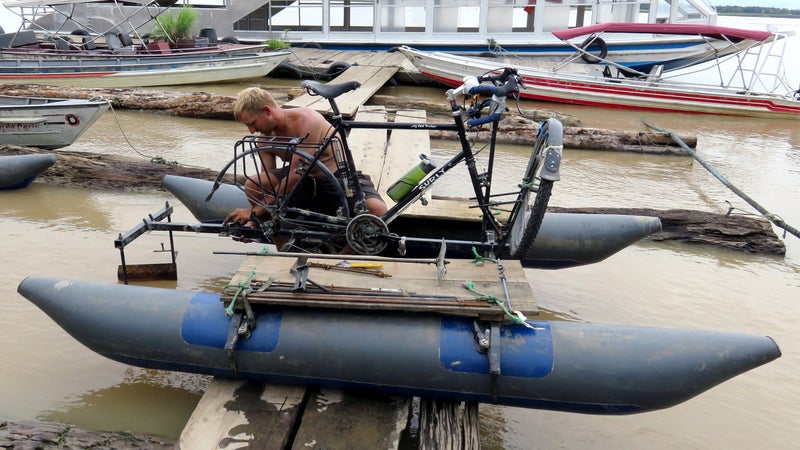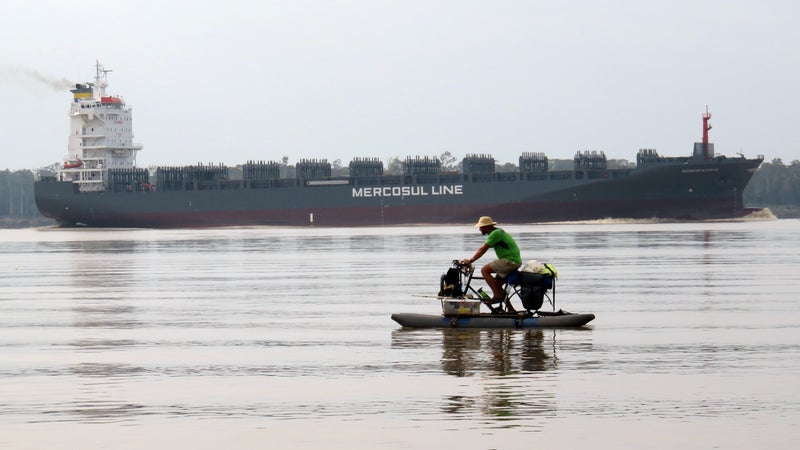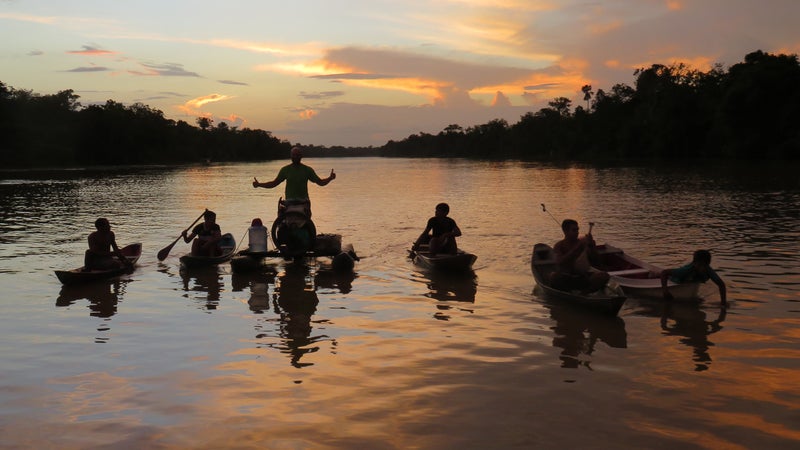Dawid Andres and Hubert Kisinski had an audacious goal: they would bike the length of the Amazon River—from the headwaters in Peru, down the Andes, through hundreds of miles of rainforest, all the way to the Atlantic. And since much of the region lacks paved roads, they would do the vast majority of the trek on homemade, floating paddle-bikes—think mountain bikes outfitted with pontoons and a pedal-powered propeller.
Pretty impressive goal for two Polish half-brothers who, by their own admission, “aren’t big bikers,” and had never been on a proper expedition before.
For two years before the pair set off last September, Andres, 40, had been poring over maps and planning the expedition from his home in Arizona. He’d originally planned a journey through the Middle East, but stories of the “extremes” of the Amazon called to him. Once he felt he had a handle on the basics of the journey, Andres flew to Arizona to meet the 32-year-old Kisinski, who lives in Poland. The two then flew to Peru and set off from Camana, on the Pacific.
In March, after nearly six months and 5,000 miles, Andres and Kisinski finished their journey where the Amazon flows into the Atlantic, becoming the first people to “bike” the Amazon.
In Poland, the men returned to a hero’s welcome. They were invited to discuss the journey in front of a crowd of several thousand at the country’s premier adventuring conference. Afterwards, to their total surprise, they were awarded the big prize of the evening for in exploring.
���ϳԹ��� caught up with the half brothers after the show to hear about the toughest parts of spending six months on the world’s second longest river.
Building the Bikes

Why bike down the Amazon? “Because it’s cheaper than kayak!” says Andres, laughing. He had originally planned to paddle the whole river, but transporting a boat to the Andes turned out to be very costly. They’d seen prototypes of bicycle-driven paddleboats on YouTube and decided they would make their own. How hard could it be?
“Everything was wrong with it,” Andres says. “After 30 minutes, Hubert’s propeller just broke.” The journey, which started 16,811 feet above sea level at lake Ticlla Cocha in Peru, quickly became a constant battle of machines versus nature.
The Amazon, with its punishing currents, chest-high waves, and whirlpools, took a tremendous toll on the men’s vehicles. On the fly, they had to improve the buoyancy of the bikes, jury-rig drive shafts—which transmitted the pedal power to the paddles instead of chains—and create spare parts wherever they could. Andres said it took hundreds of miles of on-the-go repairs to get the bikes fully sea worthy. “If we had it like this at the beginning, we would be a month faster,” he says.
Pirates on the High Seas

The most dangerous part of the trip wasn’t even the river. Much of the Amazon is extremely remote, and piracy is a constant threat. Fifteen years ago, Sir Peter Blake, one of the world’s most famous sailors, was by a gang of pirates on the river in Brazil. The Polish half brothers—who had already been robbed earlier on the journey by small time gangsters in a semi-autonomous Peruvian region occupied by the Ashaninka tribe—were constantly on the lookout. (The robbers relieved them of the cash equivalent of about $100.)
After spending Christmas with a Peruvian family that welcomed them into the fold, Andres and Kisinski were aided by the currents and making great time, covering 80 miles a day—fast, but not fast enough to escape river marauders. First, the men were accosted on the water by a pair of scrawny, unarmed 20-somethings wearing Ray Ban sunglasses. They were menacing more than anything, and after sizing up the Poles’ bikes, decided there was nothing on board worth stealing.
Shortly thereafter, the paddle-bikers encountered a greater threat in the form of a small boat motoring toward them at high speed. “There were five guys with gun and they were yelling, ‘Put your hands on the head!’” Andres says. “They started to ask us what we are doing. I’m on the bike in the waves with my hands behind my head. Guy is aiming a gun at me. Gun was huge. It was like [a gun] for the elephants.”
The pirates asked if Andres and Kisinski were transporting drugs. Andres explained they were on a biking expedition down the river, a reply that drew laughs from the bandits. One dove into the river and checked their pontoons for storage compartments. It was, Andres said, extremely tense. “So I ask them, ‘Maybe you have a beer? Pirates, do you have a beer?’ And they said no they don’t have a beer! Then [the main pirate began] laughing,” Andres said. “That was our weapon. Conversation.” The pirates let them pass unharmed, with all their belongings.
Getting Lost

Andres and Kisinski made a smart decision early on: they enlisted the help of , probably Poland’s greatest Amazon explorer. Thirty years ago, he was part of the first expedition to successfully kayak the length of the Amazon, and today the expedition website Explorers Web calls him the godfather of Amazon exploration. In the years since, he’s mentored a generation of adventurers.
When Andres asked him for help, Chmielinski was initially skeptical of the two amateurs. But when they called from the top of the Peruvian Andes, after with all their equipment, he was on board. “They are so enthusiastic,” he says. “They don’t go for record. They didn’t want to beat anything. It was assumed they will be the first bike ride along the Amazon—but really they didn’t go for this.” Chmielinski agreed to guide them from from his home in Washington, D.C., to help them with GPS navigation and communications with the outside world.
For 4,300 some odd miles, navigation was fairly simple: the paddle-bikers followed the river. But as they approached Belem, in the Amazon’s massive delta near the Atlantic coast, the river diverged into dozens of different channels, muddling their path.
With Chmielinski’s support, the explorers hunted for overland roads through the delta. “Road,” it turned out, “was a giant misunderstanding,” Chmielinksi says. The washed out dirt paths through the heavy jungle made for slow going and the two men often had to get back in the water to cross sloughs. After tens of miles, Andres and Kisinski got a call on their satellite phone. It was Chmielinski. He’d been following their movements on GPS—they were going in circles. Eventually, the pair started following telephone poles, hoping they would lead to Belem. Their vision blurry from dehydration, the pair finally made it into town.
From Belem, it was just a 120-mile bike ride along dirt roads and jungle brush to the Atlantic. Finally, on March 4, nearly six months after they left the Peruvian Andes, the pair dove into the sea. “We got the cries, a little. I’ve never been so happy,” Andres says. “We jump, we cry. Then we understood what we have done. For us, it was special.”
CORRECTION: An earlier version of this story misspelled Hubert Kisinski's name.


